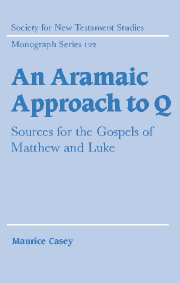Book contents
- Frontmatter
- Contents
- Preface
- List of abbreviations
- 1 The state of play
- 2 Method
- 3 Scribes and Pharisees: Matthew 23.23–36//Luke 11.39–51
- 4 John the Baptist: Matthew 11.2–19//Luke 7.18–35
- 5 Exorcism and overlapping sources: Mark 3.20–30; Matthew 12.22–32; Luke 11.14–23; 12.10
- 6 Conclusions
- Select bibliography
- Index of passages discussed
- Index of names and subjects
2 - Method
Published online by Cambridge University Press: 22 September 2009
- Frontmatter
- Contents
- Preface
- List of abbreviations
- 1 The state of play
- 2 Method
- 3 Scribes and Pharisees: Matthew 23.23–36//Luke 11.39–51
- 4 John the Baptist: Matthew 11.2–19//Luke 7.18–35
- 5 Exorcism and overlapping sources: Mark 3.20–30; Matthew 12.22–32; Luke 11.14–23; 12.10
- 6 Conclusions
- Select bibliography
- Index of passages discussed
- Index of names and subjects
Summary
In Aramaic Sources of Mark's Gospel, I proposed a methodology for reconstructing Aramaic sources of both sayings and narratives in the synoptic Gospels, where sources have been translated so literally that this is possible. I applied this methodology to four passages of Mark's Gospel, from which I sought to recover events and sayings from Jesus' historic ministry, and to establish their original interpretation. The purpose of this chapter is to restate, clarify and carry forward the main points of the proposed methodology, with particular reference to the Q material. I shall presuppose rather than repeat the rest of my previous work, and clarify points which have caused trouble in subsequent discussions.
Latin, Greek and Hebrew
I begin with the languages which were in use in Israel at the time of Jesus, and the question of which ones he is likely to have used. Latin was the language of the Roman imperial power. Jesus had no reason to learn or use Latin in general, and the Gospels do not imply any general use of Latin. Jesus will merely have used the occasional Latin loanword for a Roman object. So we find him asking for a δηνάριον at Mark 12.15//Matt. 22.19//Luke 20.24. This is the ubiquitous denarius, and the story does not make sense unless it was a real denarius, which could hardly be called anything else.
Greek was much more widely used, throughout Israel.
- Type
- Chapter
- Information
- An Aramaic Approach to QSources for the Gospels of Matthew and Luke, pp. 51 - 63Publisher: Cambridge University PressPrint publication year: 2002

